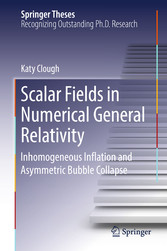Suche
Lesesoftware
Specials
Info / Kontakt
Scalar Fields in Numerical General Relativity - Inhomogeneous Inflation and Asymmetric Bubble Collapse
von: Katy Clough
Springer-Verlag, 2018
ISBN: 9783319926728 , 197 Seiten
Format: PDF
Kopierschutz: Wasserzeichen



Preis: 96,29 EUR
eBook anfordern 
Mehr zum Inhalt

Scalar Fields in Numerical General Relativity - Inhomogeneous Inflation and Asymmetric Bubble Collapse
This book explores the use of numerical relativity (NR) methods to solve cosmological problems, and describes one of the first uses of NR to study inflationary physics. NR consists in the solution of Einstein's Equation of general relativity, which governs the evolution of matter and energy on cosmological scales, and in systems where there are strong gravitational effects, such as around black holes. To date, NR has mainly been used for simulating binary black hole and neutron star mergers like those detected recently by LIGO. Its use as a tool in fundamental problems of gravity and cosmology is novel, but rapidly gaining interest.
In this thesis, the author investigates the initial condition problem in early universe cosmology - whether an inflationary expansion period could have 'got going' from initially inhomogeneous conditions - and identifies criteria for predicting the robustness of particular models. State-of-the-art numerical relativity tools are developed in order to address this question, which are now publicly available.
Katy Clough studied Engineering Science at Oxford University, before embarking on a short-lived career in finance. An Open University degree in Physics inspired her to return to academia and she subsequently completed her PhD at King's College London under the supervision of Dr Eugene Lim. Her first postdoctoral position is at Goettingen University in Germany, the former home of many great physicists and mathematicians including Riemann, Noether, Hilbert, Planck and Heisenberg. From October 2018 she will return to Oxford for a second postdoctoral position in the Beecroft Institute of Particle Astrophysics and Cosmology.
In this thesis, the author investigates the initial condition problem in early universe cosmology - whether an inflationary expansion period could have 'got going' from initially inhomogeneous conditions - and identifies criteria for predicting the robustness of particular models. State-of-the-art numerical relativity tools are developed in order to address this question, which are now publicly available.






